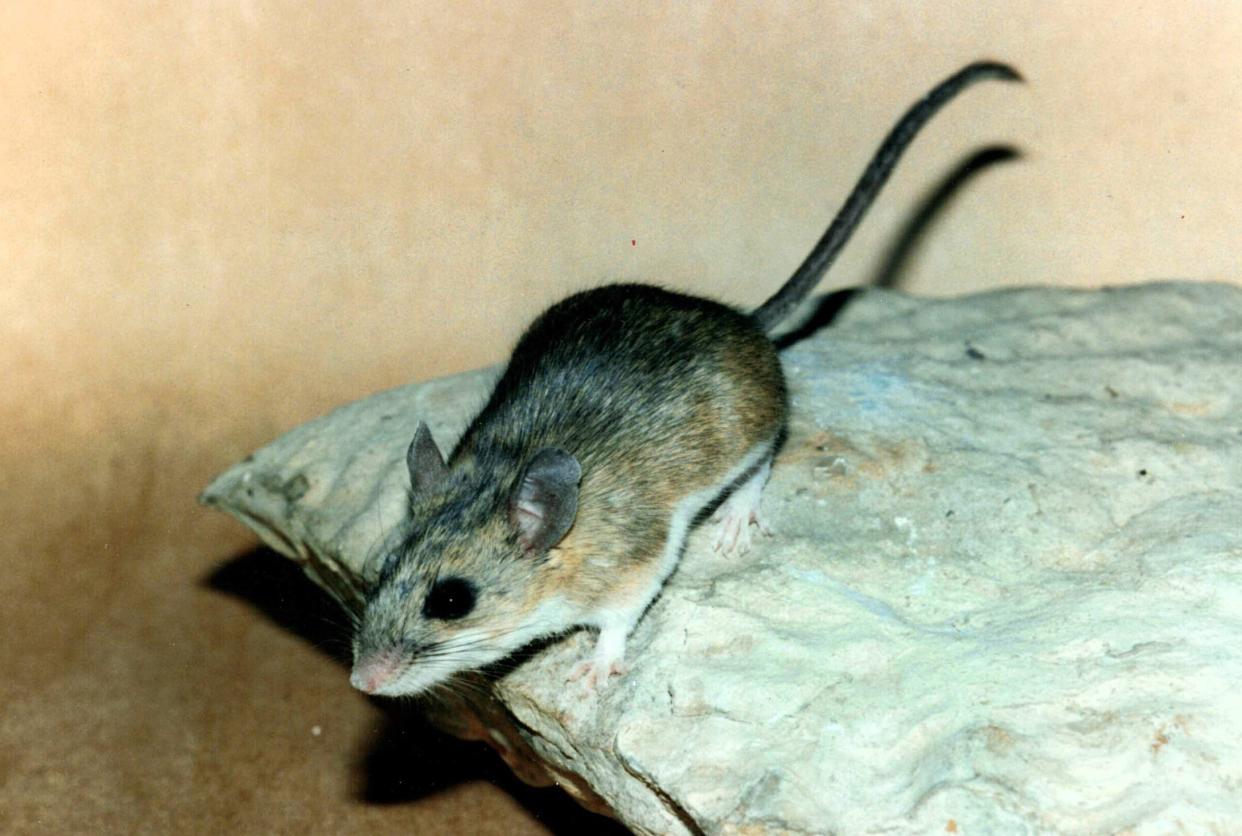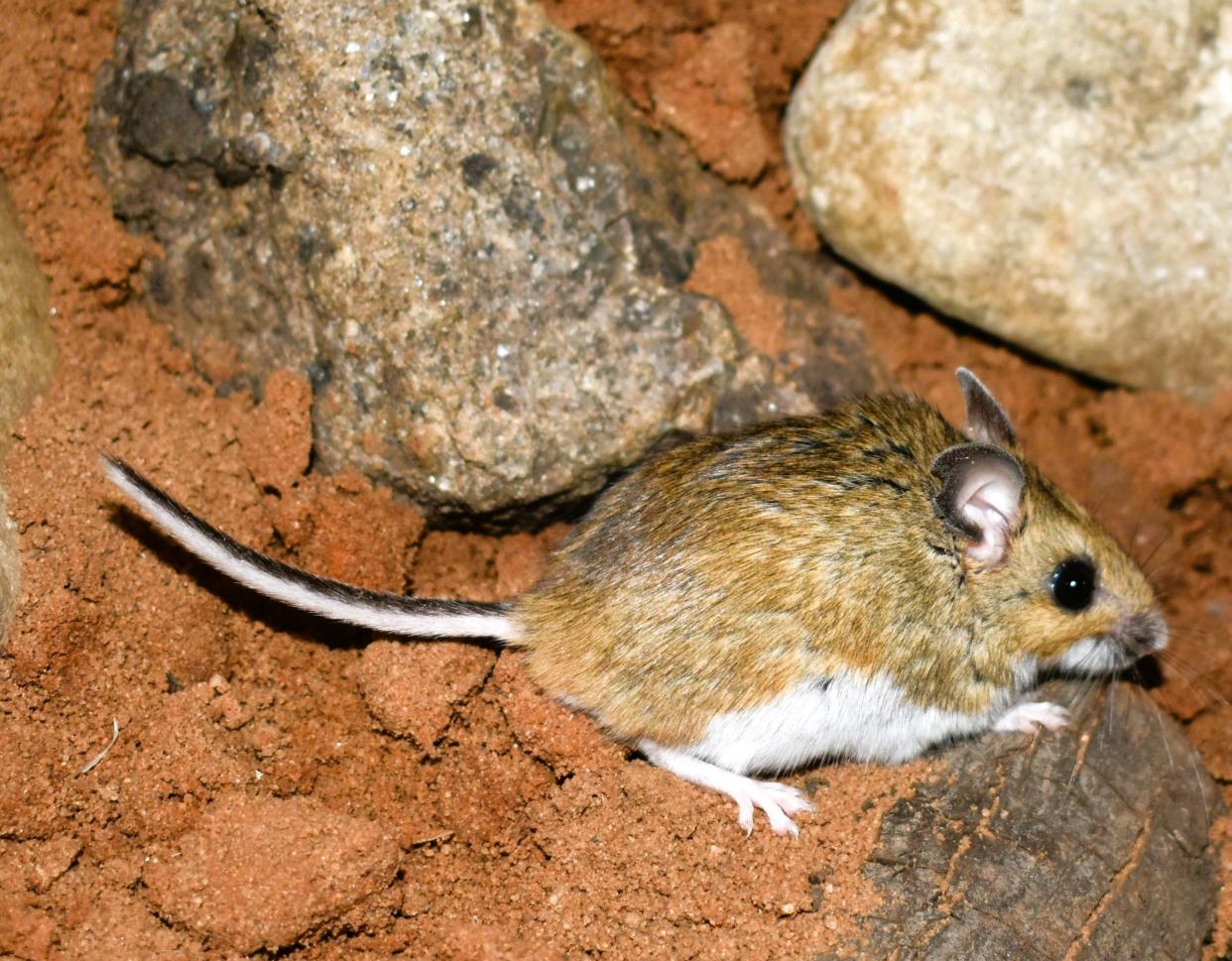This is Lacey’s white-ankled deer mouse, Peromyscus laceianus,
The Texas deer mouse and Lacey’s white-ankled deer mouse commonly inhabit rocky ridges, outcrops and escarpments in our region and, because of their association with rocks, are known as saxicolous species.
The white-footed deer mouse and the North American deer mouse most often inhabit brushy areas, mesquite pasturelands, and/or grasslands and agricultural croplands throughout the Rolling Plains.
The Texas deer mouse and Lacey’s deer mouse are also slightly larger and have longer tails, larger feet and ears than P. leucopus and P. sonoriensis.
Adult Texas and Lacey’s deer mice have narrow, orange, lower-lateral stipes which are lacking in the white-footed and North American deer mice. The Texas deer mouse may be distinguished from Lacey’s white-ankled deer mouse by the former’s larger feet, ears, and bi-colored, terminally tufted tail.
But the ankles of Lacey’s deer mouse are white as opposed to gray or brown in the Texas deer mouse and the tail of Lacey’s deer mouse is longer than its head and body length, uniform in color and only slightly tufted.
The white-footed deer mouse’s tail is not tufted and is equal to, or slightly shorter than, its head and body length. In comparison, the tail of the North American deer mouse is noticeably shorter than its head and body length with a narrow, dark, mid-dorsal stripe and no terminal tuft.
The white-footed deer mouse and North American deer mouse also have smaller feet and ears than the aforementioned, saxicolous deer mice.
Where they live
Within the Rolling Plains, white-footed deer mice are most often associated with more level pasturelands, shrublands, riparian areas, grasslands and croplands — as-long-as some canopy cover or overstory vegetation is present.
Although the smallest of the four deer mice within our region, the North American deer mouse has the largest distribution of all native, North American rodents and ranges from southern Alaska southward throughout most of Canada, the United States and Mexico.
The North American deer mouse is usually associated with open grasslands, grassy, roadside ditches, and pasture and cropland margins.

This is the Texas deer mouse, Peromyscus attwateri.
The four deer mice usually segregate according to preferred habitats, but their diets overlap and include seeds of grasses, crops, forbs, hackberry and juniper fruits, berries and nuts, lichens and fungi, insects, and some vegetable matter.
The Texas, Lacey’s white-ankled, and white-footed deer mice are somewhat arboreal and will forage within bushes and trees; whereas, the North American deer mouse is more terrestrial in its foraging habits.
All four deer mice are active throughout the year and forage during nocturnal hours.
However, the white-footed deer mouse becomes more crepuscular and diurnal during winter. Deer mice reside in burrows, underneath rocks and brush piles, in crevices, within buildings and abandoned structures and sometimes within remodeled bird nests.
Deer mice may become territorial during their reproductive season. However, the North American deer mouse has been observed communally nesting during winter months.
In the cycle of life
Deer mice are important prey species within natural communities, and their numerous predators include hawks, owls, egrets, herons, bobcats, coyotes, raccoons, skunks, weasels, badgers and various snakes.
Deer mice may reproduce throughout the year but reproductive rates usually decline during winter and late summer. Adult females can produce several litters of young per year. The average litter size is four with a range of one to nine young.

This is the North American deer mouse, Peromyscus sonoriensis.
Deer mice mature rapidly and may become reproductively active before losing their juvenile pelage. Deer mice are ideal subjects for ecological, genetic, and medical research studies because of their high reproductive potentials and rapid growth and maturity.
Dangers and deer mice
Deer mice are potential carriers of hantavirus and hosts of ticks which harbor bacteria causing Lyme disease and bubonic plague although these diseases are rarely reported in our region.
The North American and white-footed deer mice have been identified as potential vectors of hantavirus and both occur throughout Northcentral Texas and Southwestern Oklahoma. These rodents should be handled with caution (and gloves), and rodent infested areas around and in dwellings should be thoroughly cleaned and disinfected with bleach solutions.
Key to the natural community
The many different deer mice are prolific and important members of natural communities. They occupy diverse habitats throughout our area, and many people find them attractive whenever compared to house mice and other rodents.
Deer mice can become docile in captivity but probably shouldn’t be kept as pets because of their (slight though it is) potential health risks. Otherwise, deer mice have vital roles as prey species and research animals in the wilds of Northcentral Texas and Southwestern Oklahoma.

Jim Goetze
Jim Goetze is a retired professor of biology and former chairperson of the Natural Sciences Department of Laredo College with an avid interest in all aspects of the natural world. He can be contacted at [email protected].
This article originally appeared on Wichita Falls Times Record News: Goetze: On the most numerous native North American mice
Source link : https://www.aol.com/goetze-most-numerous-native-north-124517644.html
Author :
Publish date : 2024-06-23 08:45:17
Copyright for syndicated content belongs to the linked Source.












